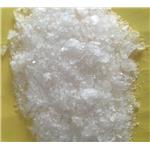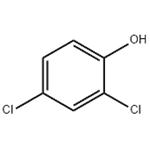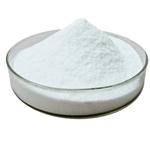- 2,4-Dichlorophenol
-

- $5.00 / 200KG
-
2024-04-24
- CAS:120-83-2
- Min. Order: 1KG
- Purity: 99%
- Supply Ability: 500mt/year
- 2,4-Dichlorophenol
-

- $100.00 / 1KG
-
2023-12-24
- CAS:120-83-2
- Min. Order: 1KG
- Purity: 99%
- Supply Ability: g-kg-tons, free sample is available
- 2,4-Dichlorophenol
-

- $0.00 / 25KG
-
2023-10-16
- CAS:120-83-2
- Min. Order: 1KG
- Purity: 99%
- Supply Ability: 50000KG/month
|
| | 2,4-Dichlorophenol Basic information |
| Product Name: | 2,4-Dichlorophenol | | Synonyms: | DICHLOROPHENOL(2,4-);1-Hydroxy-2,4-dichlorobenzene;2,4-Dichlorophenol,>85%;2,4-DichlorophenolForSynthesis;2,4-dichlorophenol solution;1,3-DICHLORO-4-HYDROXYBENZENE;2,4-Dichlorphenol;2,4-DICHLOROPHENOL 99+% | | CAS: | 120-83-2 | | MF: | C6H4Cl2O | | MW: | 163 | | EINECS: | 204-429-6 | | Product Categories: | Alphabetic;Halogenated Heterocycles ,Isoquinolines ,Quinolines ,Quinaldines;Method 552Method Specific;2000/60/EC;500 Series Drinking Water Methods;Alpha Sort;D;DAlphabetic;European Community: ISO and DIN;Volatiles/ Semivolatiles;Organic Building Blocks;Oxygen Compounds;Phenols;DIA - DICMethod Specific;Pesticides&Metabolites;Phenoles and thiophenoles;Analytical Chemistry;Chlorinated Compounds (Environmental Endocrine Disruptors);Environmental Endocrine Disruptors;Chloride chemicals;Aromatic Phenols;Organics;DIA - DICEPA;K00001 | | Mol File: | 120-83-2.mol |  |
| | 2,4-Dichlorophenol Chemical Properties |
| Melting point | 42-43 °C(lit.) | | Boiling point | 209-210 °C(lit.) | | density | 1.383 | | vapor pressure | 1.3 hPa (50 °C) | | refractive index | 1.4430 (estimate) | | Fp | 237 °F | | storage temp. | 2-8°C | | solubility | methanol: soluble1g in 10ml | | pka | pK1:7.85 (25°C) | | color | White to beige | | Water Solubility | 4.5 g/L (20 ºC) | | Merck | 14,3072 | | BRN | 742467 | | Henry's Law Constant | 2.88 x 10-6 atm?m3/mol at 20 °C (Sheikheldin et al., 2001)
3.23 x 10-6 atm?m3/mol at 25 °C (estimated, Leuenberger et al., 1985a) | | InChIKey | HFZWRUODUSTPEG-UHFFFAOYSA-N | | LogP | 3.25 at 20℃ | | CAS DataBase Reference | 120-83-2(CAS DataBase Reference) | | NIST Chemistry Reference | Phenol, 2,4-dichloro-(120-83-2) | | EPA Substance Registry System | 2,4-Dichlorophenol (120-83-2) |
| | 2,4-Dichlorophenol Usage And Synthesis |
| Description | 2,4-DCP is a colorless crystalline solid with acharacteristic odor. Molecular weight=163.00; Boilingpoint=210℃; Freezing/Melting point=45.0℃; Flashpoint=113℃. Hazard Identification (based on NFPA-704M Rating System): Health 1, Flammability 1, Reactivity 0.Slightly soluble in water. | | Chemical Properties | 2,4-DCP is a colorless crystalline solid with
a characteristic odor | | Chemical Properties | white to beige crystalline solid | | Physical properties | Colorless to yellow crystals with a sweet, musty, or medicinal odor. At 40 °C, the average odor
threshold concentration and the lowest concentration at which an odor was detected were 29 and
5.4 μg/L, respectively. Similarly, at 25 °C, the average taste threshold concentration and the
lowest concentration at which a taste was detected were 2.5 and 0.98 μg/L, respectively (Young et
al., 1996). | | Uses | Intermediate in production of herbicidal
chlorophenoxy acids such as 2,4-
dichlorophenoxyacetic acid | | Uses | 2,4-Dichlorophenol is a chlorinated derivative of phenol and is used as an intermediate for the preparation of herbicide 2,4-dichlorophenoxyacetic acid (D435680). | | Definition | ChEBI: A dichlorophenol that is phenol carrying chloro substituents at positions 2 and 4. | | Synthesis Reference(s) | Synthetic Communications, 20, p. 2991, 1990 DOI: 10.1080/00397919008051517 | | General Description | Colorless crystalline solid with a medicinal odor. Melting point 45°C. Sinks in water. Strong irritant to tissues; toxic by ingestion. | | Air & Water Reactions | Insoluble in water. | | Reactivity Profile | 2,4-Dichlorophenol can react vigorously with oxidizing agents. Can also react with acids or acid fumes. Incompatible with acid chlorides and acid anhydrides. | | Health Hazard | Tremors, convulsions, shortness of breath, inhibition of respiratory system. | | Safety Profile | Suspected carcinogen
with experimental carcinogenic and
teratogenic data. Poison by intraperitoneal
route. Moderately toxic by ingestion and
subcutaneous routes. An experimental
teratogen. Mutation data reported.
Combustible when exposed to heat or
flame. Can react vigorously with oxidizing
materials. To fight fre, use alcohol foam,
foam, CO2, dry chemical. When heated to
decomposition, or on contact with acid or
acid fumes, it emits hghly toxic fumes of
Cl-. See also CHLOROPHENOLS. | | Potential Exposure | 2,4-Dichlorophenol is a commercially
produced substituted phenol used in the manufacture
of industrial and agricultural products; in synthesis of
pharmaceuticals. As an intermediate in the chemical industry, 2,4-DCP is utilized as the feedstock for the manufacture of 2,4-dichlorophenoxyacetic acid (2,4-D), and 2,4-D
derivatives (germicides, soil sterilants, etc.); certain methyl
compounds used in mothproofing, antiseptics and seed
disinfectants. 2,4-DCP is also reacted with benzene sulfonyl
chloride to produce miticides or further chlorinated to
pentachlorophenol, a wood preservative. It is thus a widely
used pesticide intermediate. The only group expected to be
at risk for high exposure to 2,4-DCP is industrial workers
involved in the manufacturing or handling of 2,4-DCP
and 2,4-D | | First aid | If this chemical gets into the eyes, remove anycontact lenses at once and irrigate immediately for at least15 min, occasionally lifting upper and lower lids. Seekmedical attention immediately. If this chemical contacts theskin, remove contaminated clothing and wash immediatelywith soap and water. Speed in removing material from skinis of extreme importance. Shampoo hair promptly if contaminated. Seek medical attention immediately. If thischemical has been inhaled, remove from exposure, beginrescue breathing (using universal precautions, includingresuscitation mask) if breathing has stopped and CPR ifheart action has stopped. Transfer promptly to a medicalfacility. When this chemical has been swallowed, get medical attention. Give large quantities of water and inducevomiting. Do not make an unconscious person vomit. | | Carcinogenicity | In mammalian cells in vitro 2,4-DCP produced
chromosomal aberrations and induced
unscheduled DNA synthesis; it was negative
for sister chromatid exchange in vivo and was
mostly negative in bacterial assays.
Oral exposure of pregnant rats to
750mg/kg/day for 10 gestational days induced
slightly decreased fetal weight, delayed ossification
of sternal and vertebral arches, and some
early embryonic deaths.10 Maternal deaths also
occurred at this dose, indicating that 2,4-DCP
was not selectively toxic to embryos or fetuses.
No effects were noted in dams or offspring
exposed at 375mg/kg/day.
A threshold limit value (TLV) has not been
established for 2,4-dichlorophenol. | | Environmental fate | Biological. In activated sludge, 2.8% mineralized to carbon dioxide after 5 d (Freitag et al.,
1985). In freshwater lake sediments, anaerobic reductive dechlorination produced 4-chlorophenol
(Kohring et al., 1989). Chloroperoxidase, a fungal enzyme isolated from Caldariomyces fumago,
converted 9 to 12% of 2,4-dichlorophenol to 2,4,6-trichlorophenol (Wannstedt et al., 1990). When
2,4-dichlorophenol was statically incubated in the dark at 25 °C with yeast extract and settled
domestic wastewater inoculum, significant biodegradation with rapid adaptation was observed. At concentrations of 5 and 10 mg/L, 100 and 99% biodegradation, respectively, were observed after 7
d (Tabak et al., 1981). In activated sludge inoculum, 98.0% COD removal was achieved. The
average rate of biodegradation was 10.5 mg COD/g?h (Pitter, 1976).
Surface Water. Hoigné and Bader (1983) reported 2,4-dichlorophenol reacts with ozone at a rate
constant of <1,500/M?sec at the pH range of 1.5 to 3.0.
Groundwater. Nielsen et al. (1996) studied the degradation of 2,4-dichlorophenol in a shallow,
glaciofluvial, unconfined sandy aquifer in Jutland, Denmark. As part of the in situ microcosm
study, a cylinder that was open at the bottom and screened at the top was installed through a cased
borehole approximately 5 m below grade. Five liters of water was aerated with atmospheric air to
ensure aerobic conditions were maintained. Groundwater was analyzed weekly for approximately
3 months to determine 2,4-dichlorophenol concentrations with time. The experimentally
determined first-order biodegradation rate constant and corresponding half-life were 0.20/d and
3.47 d, respectively.
Photolytic. In distilled water, photolysis occurs at a slower rate than in estuarine waters
containing humic substances. Photolysis products identified in distilled water were the three
isomers of chlorocyclopentadienic acid. The following half-lives were reported for 2,4-
dichlorophenol in estuarine water exposed to sunlight and microbes: 0.6 and 2.0 h during summer
(24 °C) and winter (10 °C), respectively; in distilled water: 0.8 and 3.0 h during summer and
winter, respectively; in poisoned estuarine water: 0.7 and 2.0 h during summer and winter,
respectively (Hwang et al., 1986). When titanium dioxide suspended in an aqueous solution was
irradiated with UV light (λ = 365 nm), 2,4-dichlorophenol was converted to carbon dioxide at a
significant rate (Matthews, 1986). An aqueous solution containing hydrogen peroxide and
irradiated by UV light (λ = 296 nm) converted 2,4-dichlorophenol to chlorohydroquinone and 1,4-
dihydroquinone (Moza et al., 1988). A carbon dioxide yield of 50.4% was achieved when 2,4-
dichlorophenol adsorbed on silica gel was irradiated with UV light (λ >290 nm) for 17 h (Freitag
et al., 1985).
Chemical/Physical. 2,4-Dichlorophenol will not hydrolyze to any reasonable extent (Kollig,
1993). Reported second-order rate constants for the reaction of 2,4-dichlorophenol and singlet
oxygen in water at 292 K: 7 x 106/M?sec at pH 5.5, 2 x 106/M?sec at pH 6, 1.0 x 105/M?sec at pH
6.65, 1.5 x 106/M?sec at pH 7.0, 7.6 x 105/M?sec at pH 7.9, 1.20 x 104/M?sec at pH 9.0 to 9.6. At
pH 8, the half-life of 2,4-dichlorophenol is 62 h (Scully and Hoigné, 1987). In an aqueous
phosphate buffer at 27 °C, 2,4-dichlorophenol reacted with singlet oxygen at a rate of 5.1 x
106/M?sec (Tratnyek and Hoigné, 1991). At neutral pH, 2,4-dichlorophenol was completely
oxidized by potassium permanganate (2.0 mg/L) after 15 min (quoted, Verschueren, 1983). | | storage | Color Code—Blue: Health Hazard/Poison: Storein a secure poison location. Prior to working with 2,4-DCPyou should be trained on its proper handling and storage.Store in tightly closed containers in a refrigerator awayfrom oxidizers, acid, acid fumes, acid chlorides, acid anhydrides, caustics. A regulated, marked area should be established where this chemical is handled, used, or stored incompliance with OSHA Standard 1910.1045. | | Shipping | UN2020 Chlorophenols, solid, Hazard Class:
6.1; Labels: 6.1-Poisonous materials | | Purification Methods | Crystallise it from pet ether (b 30-40o). Purify it also by repeated zone melting, using a P2O5 guard tube to exclude moisture. It is very hygroscopic when dry. [Beilstein 6 IV 885.] | | Incompatibilities | Incompatible with oxidizers (chlorates,
nitrates, peroxides, permanganates, perchlorates, chlorine,
bromine, fluorine, etc.); contact may cause fires or explosions. Keep away from alkaline materials, strong bases,
strong acids, oxoacids, and epoxides. Contact with acids or
acid fumes causes decomposition releasing poisonous
chlorine gas. Incompatible with caustics, acid anhydrides;
acid chlorides. Quickly corrodes aluminum; slowly
corrodes zinc, tin, brass, bronze, copper and its alloys. May
accumulate static electrical charges, and may cause ignition
of its vapors. | | Waste Disposal | Dissolve in a combustible
solvent and incinerate in a furnace equipped with afterburner and scrubber. In accordance with 40CFR165,
follow recommendations for the disposal of pesticides and
pesticide containers. Must be disposed properly by following package label directions or by contacting your local or
federal environmental control agency, or by contacting
your regional EPA office. Consult with environmental
regulatory agencies for guidance on acceptable disposal
practices. Generators of waste containing this contaminant
(≧100 kg/mo) must conform with EPA regulations
governing storage, transportation, treatment, and waste
disposal |
| | 2,4-Dichlorophenol Preparation Products And Raw materials |
| Raw materials | Phenol-->Sulfuryl chloride-->Graphite-->2-Chlorophenol-->2,6-Dichlorophenol-->Diphenyl sulfide-->2,4,6-Trichlorophenol-->Coil pipe | | Preparation Products | 4-Chlorophenol-->Bifenox-->2-Chlorophenol-->Oxadiazon-->Bithionol-->2,4-Dichlorophenoxyacetic acid-->Triclosan-->2,5-Dichlorophenol-->Prothiofos-->2,4-Dichloro-5-nitrophenol-->(R)-2-(2,4-Dichlorophenoxy)propanoic acid-->2,4-DICHLORO-1-(2-PROPYNYLOXY)BENZENE-->azafenidin-->DICLOFOP-METHYL-->Dichlorprop-->5-chloro-alpha,alpha-bis(3,5-dichloro-2-hydroxyphenyl)-2-toluenesulfonic-->DICHLOFENTHION-->NITROFEN |
|